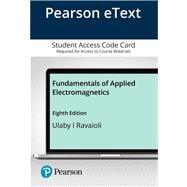Bridging the gap between circuits and electromagnetics.
Fundamentals of Applied Electromagnetics discusses circuits and electromagnetic materials, leading you from familiar concepts to more advanced topics and applications. Hands-on simulation modules, graphs and illustrations help you draw connections between concepts and their real-world uses.
For courses in electromagnetics.
Pearson eText is an easy-to-use digital textbook that you can purchase on your own or instructors can assign for their course. The mobile app lets you keep on learning, no matter where your day takes you, even offline. You can also add highlights, bookmarks, and notes in your Pearson eText to study how you like.
NOTE: This ISBN is for the Pearson eText access card. Pearson eText is a fully digital delivery of Pearson content. Before purchasing, check that you have the correct ISBN. To register for and use Pearson eText, you may also need a course invite link, which your instructor will provide. Follow the instructions provided on the access card to learn more.










